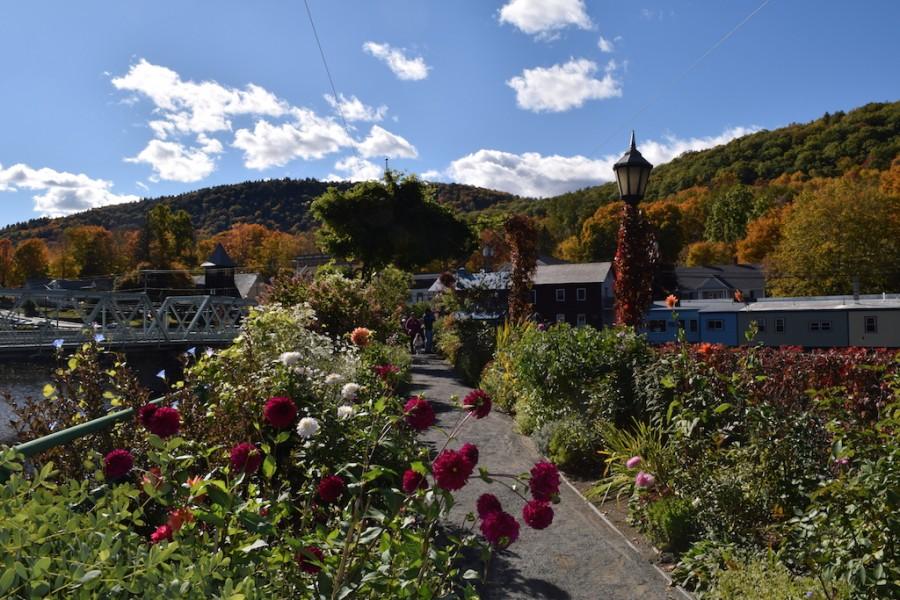Community blooms at the Bridge of Flowers
The Bridge of Flowers stretches across the Deerfield River, linking the small towns of Buckland and Shelburne — two out of the 10 towns that make up the greater Shelburne Falls area. The towns, with populations of about 2,000 each, have welcomed approximately 35,000 bridge-seeking visitors from over 91 different countries to date. People flock to the famous landmark to paint, revisit memories, relax, photograph, propose to spouses, and, of course, smell the flowers.
Visitors are intimately connected with both nature and community when walking across the 400-foot-long bridge. Clusters of shrubs align the walkway, while vines hug the fence and climb the light posts. Bright roses stand erect, as poised as the business woman who visits on her lunch break at noon, and whose high heels leave pea-sized prints in the pebbled path. Mothers push babies in strollers and a young couple walks hand-in-hand past dried hydrangeas in shades of sepia that passively shimmy in the wind. Ruby dahlias slump over the path, bobbing gingerly and beckoning a nod-like greeting.
The visitor center compiles all of the information from the optional sign-in sheets located at either end of the bridge. The sheets reveal a diverse visitors list, with signatures of people from Israel following those from Alabama.
“It’s crazy to think that our little town would be such a draw. It’s our little corner of the world,” says Elaine Parmett, co-chair of the Bridge of Flowers Committee and member of the Shelburne Falls Area Women’s Club.
The horticultural Mecca was originally built in 1908 as a functioning trolley line. Subsequent to the decline of trolleys, the bridge was closed in 1928 but could not be torn down because a pipeline connecting both towns ran beneath it. The following year, a local Shelburne Falls couple, Walter and Antoinette Burnham, decided to turn the condemned structure into an alluring community space.
While the Burnhams were the pioneers behind the Bridge of Flowers, the Women’s Club, founded in 1925, was integral in making it a reality. Currently, the club, which oversees the Bridge of Flowers Committee, has approximately 100 members from the Shelburne Falls area . The committee is non-profit with 14 members, including Parmett and co-chair Nan Fischlein.
Fischlein, a Shelburne native, remembers walking on the bridge with her grandmother when she was a little girl, and enjoys implementing what she learns there in her own garden. Parmett, a University of Massachusetts Amherst alumna, moved to Buckland in the 1970’s, having no prior knowledge of the bridge’s significance to the town. She tries to walk it at least once a week.
“The Fire and Water District own the bridge, but we are the guardians of the bridge,” says Parmett of the committee and its volunteers.
One of the main “guardians” is head gardener Carol DeLorenzo. She, along with assistant gardener Elliston Bingham and the Blossom Brigade, is responsible for the harlequin layout of the garden. Blossom Brigade volunteers come every Friday during the season, usually a range of eight to 12 people weekly. Some come once a year, while others commute as far as Connecticut to help out each week.
The commute to work is mere blocks for DeLorenzo, who lives in Shelburne. She moved there from Boston in 2000 and was hired as head gardener that same year.
“I have the best job in town,” DeLorenzo, who previously worked in landscaping and on a flower farm, says. “Who else gets to garden on a river and get paid for it?”
DeLorenzo gardens vertically by layering plants to utilize the compact space. Recently, she has been working with shrubs and small trees, which, because of the bridge’s arches and changes in depth, she places in tubs to contain the roots. Annual plants account for approximately 40 percent of the garden, and perennials the remainder.
DeLorenzo is hesitant to add inventory to the bridge’s collection of over 500 plants, and is just as hesitant to remove anything; the garden naturally generates its own aesthetic, she says.
When she walks the bridge, she looks out over her workspace with pride.
“Gardens are an interface for people, and sometimes their first step towards accessing nature. I love being a part of that process,” she says.
The Bridge of Flowers is open from April 1 through October 30. Gates reopen annually, from the day after Thanksgiving to December 30, as permitted by weather. Visitors can accomplish some holiday shopping at the many local shops and take a lighted night stroll on their trip to the bridge. It is roughly a 40-minute drive from the Amherst area.
For more information on the Bridge of Flowers, and a comprehensive list of the flowers that grow there, click here.
Erica Garnett can be reached at [email protected], or on Twitter @GarnettErica.







